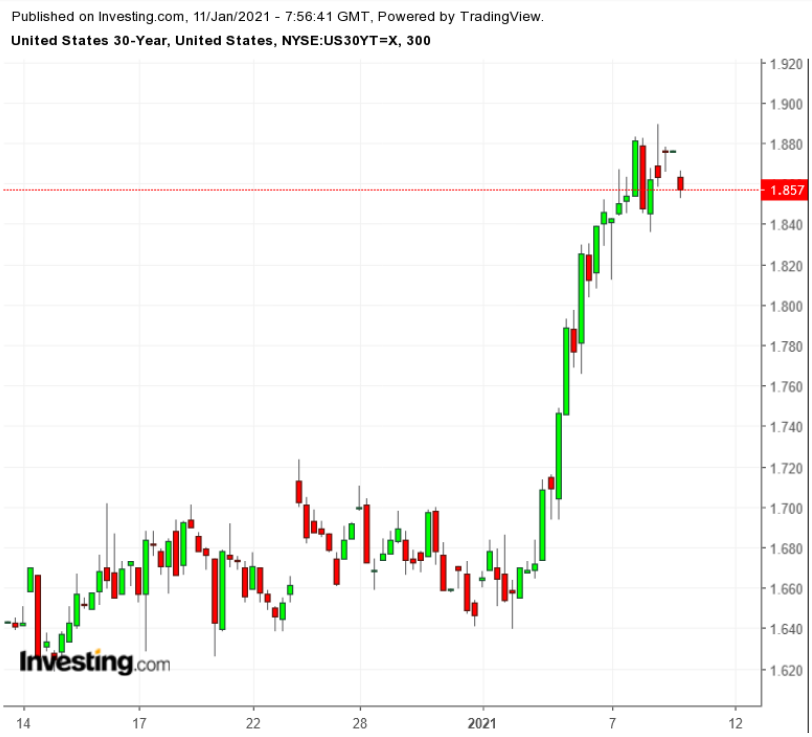Bond investors kept their eye on the ball as the prospect of a Democratic president and Democratic control of Congress makes further stimulus and other government spending a near-certainty.
Markets shrugged off an historic mob riot}} at the US Capitol and the first decline in employment since the initial plunge in March to push yields on the benchmark 10-year note to 1.12%, with a gain of 5 basis points on Friday alone, despite the disappointing jobs report.
Higher Yields Pressure Gold; €175B European January Sovereign Issues
The 10-year breached the 1% yield last week on news that Democrats had won both seats in the Georgia runoff votes, giving the party control of the Senate as well as the House.

The 30-year Treasury yield, meanwhile, rose a further 4 bps Friday to hit 1.89%. Gold prices tumbled as investors abandoned that non-interest-bearing safe haven for higher bond yields.
A heavy slate of Treasury auctions this week calls for sales of $58 billion of three-year notes, $38 billion of 10-year notes, and $24 billion of 30-year bonds, as higher yields are expected to whet investor appetites.
Employment fell by 140,000 in December, though the headline rate remained unchanged at 6.7%. Employment growth in professional services, retail trade, and construction partially offset the declines in leisure, hospitality, and private education due to a resurgence of COVID-19 infections and renewed lockdowns.
Analysts expect Democrats to pass a stimulus on the order of another $900 billion to $1 trillion on top of the $900 billion passed in December.
Aside from politics and the fiscal stimulus, attention was focused on the prospect for increased inflation. Much was made of the 10-year breakeven inflation rate—derived from the difference in yield between inflation-protected and conventional Treasuries—which rose above 2% for the first time since 2018. Given the Fed’s avowed policy of letting inflation run well above its 2% target for some time, the breakeven rate would have to get a good deal higher to set off alarms.
Analysts expect the yield curve to steepen as the US and other issuers shift their borrowing to longer-term maturities, locking in low rates for longer periods, and institutional investors flock to the higher yields. The Fed and other central banks may well follow them with their asset purchases, which will continue at a high rate.
The gap between yields on the two-year and 10-year Treasuries—a closely watched measure of the yield curve—widened to 0.99% by the end of last week, compared with 0.80% a week earlier. The Fed, however, can check any excessive rise in long-term rates by shifting its bond purchases to longer maturities.
In Europe, sovereign borrowers may sell bonds for as much as €175 billion in January alone, according to one estimate. France, which is expected to borrow €260 billion in 2021, kicked off the year with an offering of €11 billion in 10-, 20-, and 30-year bonds, with the longer-dated maturities priced for a positive yield.
Italy came out atypically with an early offering of €10 billion in {{23739|15-year bonds, drawing €110 billion in orders. Spain, Germany, Ireland, and Slovenia all came to the market in the first week of the New Year. Germany says it will sell about €470 billion in bonds this year, with a net €200 billion in new issuance.
Investors in eurozone sovereign bonds, unlike those buying US Treasuries, are not anticipating higher inflation as European Central Bank buying keeps yields depressed.
